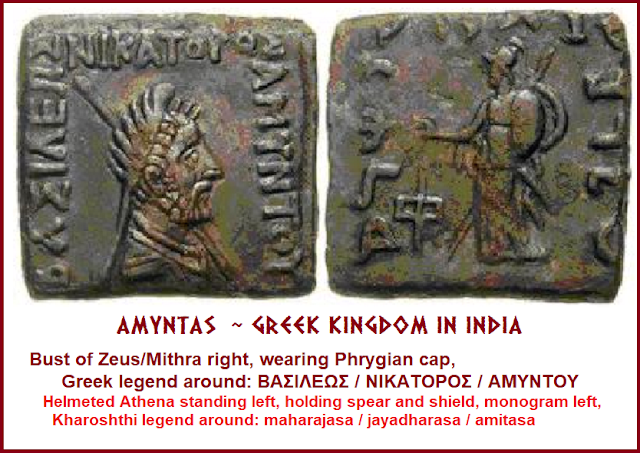Striving for realism in sculptural modelling, movement and expression became the major force motivating Hellenistic art. Perhaps there was a desire to impress subjects of the realm with the true appearance of their lawful monarch which led to engrave the portraits on the coins of Bactrian Greeks and Seleucids. Alexander was the first emperor to put his portrait on his coins and the practice was inherited by his successors in India. Extraordinary realism of their portraiture and the Praxitelean character of the full length images of deities on the reverse were the prime attributes of their coins. It is not clear whether Alexander himself has issued any coins in his name during his sojourn in India. But it is a fact that his coins are a great rarity in India and it seems that his coins have come from Bactria.
The gold and silver coins with fabulous portraits, which circulated in Bactria were never current in India as they fall under Greek coinage category. The coins with the portrait head and bilingual fall under Indian coinage. The Seleucid king Antiochus I (293-280 BCE) is shown on his coins with all the paths of humanity, the divine power is clearly reflected in Seleucus' coins. Demetrios I was the first ruler to strike square copper coins in bilingual format, Kharoshti on the reverse and Greek on the obverse. Silver coins underwent radical change upon the movement of government to south of Hindu Kush, and the coins were called Didrachm and Hemidrachms. Generally, coins are circular, exceptions are the few square ones of Appollodotos and Philoxenos.
The portraits of early Indo Greek rulers such as Euthydemos-I, Demetrios-I (wearing an elephant's scalp) and Antimachus (wearing Kausia - a flat shaped cap and with a smiling face) are so realistic in appearance, that the coin portrait seems to represent the ruler faithfully. The coins of Demetrious-II, Euthydemos-II, Pantaleon, Agathocles, Menander and Strato-I are also assigned to the same class as they express powerful features and very intricate personal details. The portrait of Eucradites-I and the bust of members of the house of Eucradites-I is so realistic that their coins indicate rigid majesty, tendency for idealization and the taste for symbolic ornamentation when compared to the coins of house of Euthedemos. Some of the coins of this house carried the image of the king on horseback. Notably, the Dioskouri, the Greek heroes featured in Eukratides's coins exhibit the horsemanship and prowess in battle through the raised spears. The coins of Appollophanes, Philoxenos and Theophilos are extremely rare and hence leads to suspect that they were the pretenders. Perhaps all the Indo- Greek coins may have been the products of a single school of engravers; the realism makes us believe that they were familiar with the Hellenestic school of Pergamon.
Indo-Greeks were excellent coin smiths and the fabric far exceeded than the true Greek coins. Indo-Greeks did not like abstract shapes and they modified Greek Gods to look like Indians. Upon the arrival of the Greeks, the sculptural techniques were heavily influenced by them. Indo-Greeks kept very close to their Greek roots,something which can be seen in the bilingual legends they carried on their coins. During that time, India saw a revolution in art and culture. The Gods for whom the Indo-Greek artists laboured had hardly changed for many generations : Apollo, the intellectual God of Arts and Music, Zeus, the King of the Gods and Hera, His consort, Artemis, the Virgin Huntress, muscular Heracles, the God of Strength, Athena the Goddess of Wisdom, Aphrodite, the Goddess of Love, Dionysos, the God of Ecstasy, and winged deities Nike and Eros. Helios, Poseidon, Demeter, the Dioskouri and Tyche are the other Greek divinities which could be seen in their coinage. Many of these images iconographically influenced the Indian pantheon at a later stage.
The vitality of the Hellenistic Art school is reflected in the coins the Indo- Greek engravers made. Bold reliefs were employed on large flans to impart three dimensional effect of images and legends; The marginal borders and the legends along with the borders set the boundary. Clearly formed cheeks, broad smooth forehead, deep furrows which divide hair and beard, muscular bare body with every minute anatomical detail are reflected in their coinage. Though drapery is so thick, the movement is exhibited by the position of the limbs or partial torsion of the body. The figures are created in such a magnificent style, that the light and shadow highlight the liveliness of image.
On the reverse of Eukratides's copper, we see the figure of seated Zeus along with the legend in Kharoshti 'The city deity of Kapisa'. The later kings Strato-I and Hermaios struck coins with debased silver and even in lead. One of the copper coins of Hermaios, the legend Kujula Kadphises appears on the reverse. Probably this could be assumed that the dynasty was succeed by the Kushans.
SOURCE: forumancientcoins.com


























No comments:
Post a Comment